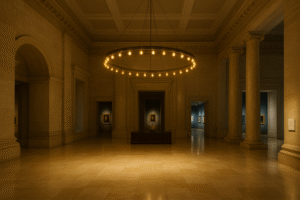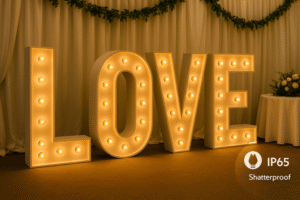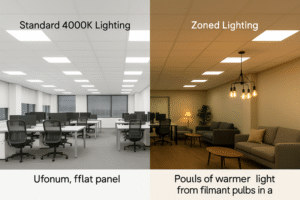Your building is a landmark by day but disappears into the darkness at night. This invisibility means missed opportunities for branding and leaves the property looking uninviting and potentially unsafe.
Yes, architectural LED lighting can completely transform a building's nighttime presence. By strategically using durable, controllable fixtures, you can highlight architectural features, create a specific mood, enhance brand identity, and improve safety, making your building stand out 24/7.
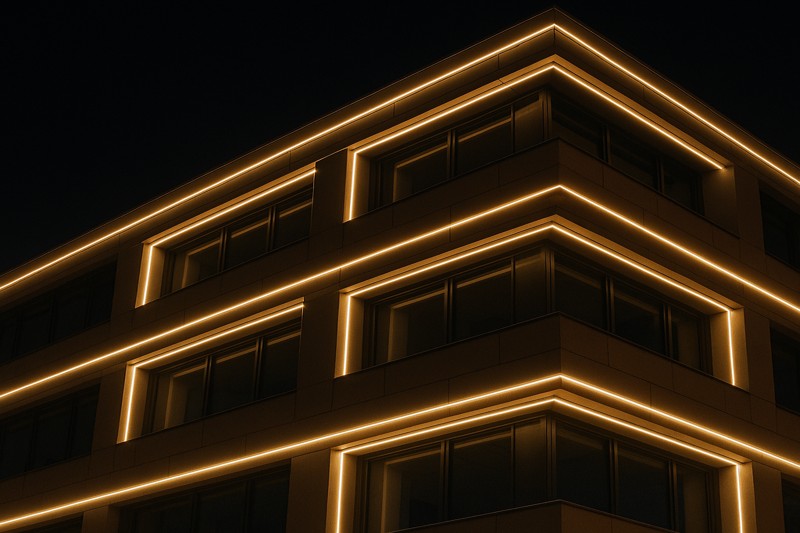
I remember talking with a hotel owner, Jacky, who was frustrated that his beautiful, historic building just vanished after sunset. He had invested so much in the architecture, but at night, it had zero curb appeal. We discussed how modern LEDs weren't just about brightness; they were about painting with light. He initially thought it would be too complex or fragile for an outdoor application. I explained that today’s exterior-grade LEDs are built to withstand anything. This conversation opened his eyes to the possibilities. Let's look at how these projects come to life.
Can Modern Lighting Survive the Harshest Weather?
Are you worried that installing exterior lights is a waste of money? Constant exposure to rain, dust, and temperature swings can cause traditional fixtures to fail quickly, leading to costly repairs.
Absolutely. Modern facade lighting uses LEDs with high Ingress Protection (IP) ratings, like IP44, IP54, or higher. These fixtures are sealed in durable materials like die-cast aluminum to resist dust and water, ensuring long-term reliability.
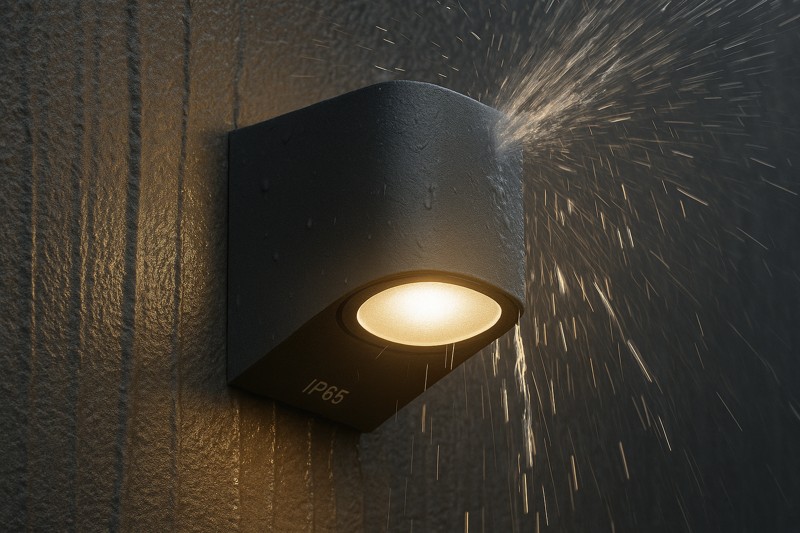
The first question any property owner asks is, "Will it last?" And it's a valid concern. Exterior fixtures face a constant battle with the elements. We can't afford to install something that needs constant maintenance. That's why the engineering behind these lights is so important. We look for fixtures built from robust materials like die-cast or powder-coated aluminum, which resist corrosion. The glass also needs to be tough, which is why tempered or pirex glass is often used. But the most critical factor is the IP rating. This two-digit number tells you exactly how protected a fixture is. For example, a light with an IP44 rating is protected from splashing water from any direction, making it suitable for many wall-mounted applications. A higher rating, like IP54, offers even more protection against dust, which is crucial in urban or industrial areas. This focus on durability ensures the initial investment continues to pay off for years.
Understanding IP Ratings for Exteriors
| IP Rating1 | Protection Against Solids | Protection Against Liquids2 | Common Application |
|---|---|---|---|
| IP43 | Protected from objects >1mm | Protected from water spray < 60° from vertical | Sheltered areas like under eaves. |
| IP44 | Protected from objects >1mm | Protected from splashing water from any direction | General-purpose wall lighting. |
| IP54 | Dust protected | Protected from splashing water from any direction | Areas with more exposure to dust and debris. |
How Do You Choose the Right Light for Each Architectural Feature?
Does your building's facade look flat and one-dimensional at night? Using a single type of light everywhere fails to create depth, drama, or focus, washing out the unique details of the architecture.
A successful design uses a mix of fixtures for specific tasks. Use spotlights to highlight columns, in-ground units to uplight walls, and decorative lamps to accent entrances, creating a layered and dynamic look.
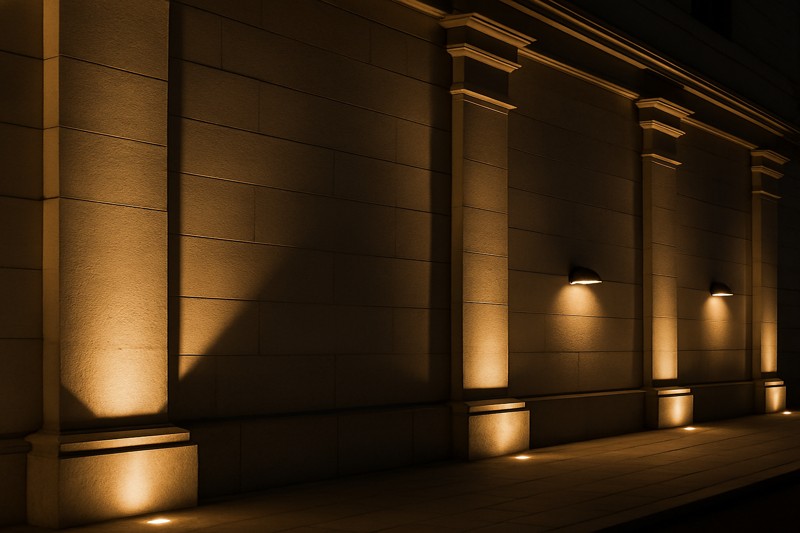
Painting with light requires a full palette of brushes. You wouldn't use a giant roller to paint a fine detail, and the same is true for lighting. The key is to create layers of light that build a visual hierarchy. I advise clients to start by identifying the building's most important features. Are there grand columns? A unique texture on a wall? An impressive entryway? For each feature, we select the right tool. To create dramatic uplighting effects that emphasize height, we can use in-ground spotlights. To highlight a specific sign or architectural element, an adjustable spotlight with a GU10 bulb is perfect because you can aim it precisely where you need it. Then, for areas like balconies or entrances, using more decorative fixtures can add a touch of elegance and create a welcoming atmosphere. This approach doesn't just illuminate the building; it tells a story and guides the eye.
Matching Fixtures to Functions
- Uplighting Walls3: In-ground fixtures are perfect for grazing a textured wall or making a flat surface appear taller and more imposing.
- Highlighting Columns4: Using adjustable spotlights at the base of columns creates dramatic shadows and emphasizes their three-dimensional form.
- Accenting Entrances: Wall-mounted fixtures with opal plastic diffusers provide soft, welcoming, and glare-free light for guests and visitors.
- Defining Edges: Linear fixtures or a series of small spotlights can be used to trace the roofline or the edges of the building, outlining its silhouette against the night sky.
Does the Color of Light Affect a Building's Mood?
Does the light on your building feel cold and sterile, or old and yellow? The wrong color temperature can misrepresent your brand, making a modern building feel dated or a classic structure feel harsh.
Yes, the color temperature is critical for setting the right tone. A warm white (3000K) creates a classic, welcoming feel, while a neutral white (4000K) provides a clean, modern, and crisp look suitable for contemporary architecture.
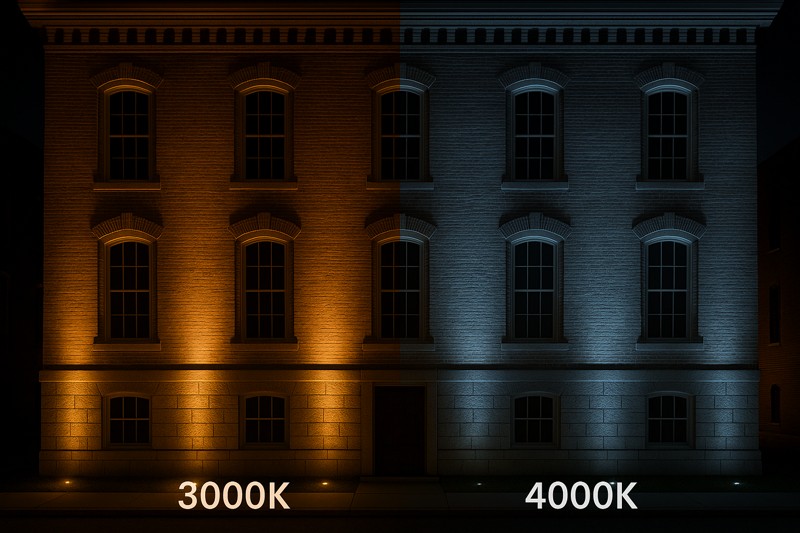
Color temperature is one of the most powerful and simple tools for controlling a building's emotional impact. When I consult on a project, this is one of the first decisions we make. It has to align with the brand identity and the architectural material. For a historic building with brick or stone, a warm white light around 3000K brings out the warmth and texture of the materials, creating a welcoming and prestigious feel. For a sleek, modern structure with lots of glass and metal, a neutral white light of 4000K can accentuate the clean lines and crisp geometry, making it feel innovative and efficient. It is also critical that the lights have a high Color Rendering Index (CRI), usually over 80, to ensure the building's materials look true to their natural color and not washed out or distorted. Choosing the right color temperature is a deliberate design choice that speaks volumes before a visitor even steps inside.
Selecting the Right Color Temperature
| CCT Value | Color Appearance5 | Ideal Architectural Style | Brand Perception6 |
|---|---|---|---|
| 2200K-2700K | Very Warm White | Historic landmarks, luxury hotels, rustic venues | Evokes feelings of comfort, heritage, and exclusivity. |
| 3000K | Warm White | Classic architecture, residential buildings, restaurants | Friendly, welcoming, and professional. |
| 4000K | Neutral White | Modern commercial offices, healthcare facilities, retail centers | Clean, efficient, and contemporary. |
Can You Create Dynamic Facades Without Complex Systems?
Do you think creating an eye-catching facade requires a complicated and expensive control system? The idea of programming complex light shows can be intimidating and seem out of reach for many projects.
Yes, you can create dynamic effects with simple strategies. By using fixtures with adjustable bodies and lenses, you can shape light beams precisely. Combining different beam angles creates contrast and visual interest without complex programming.
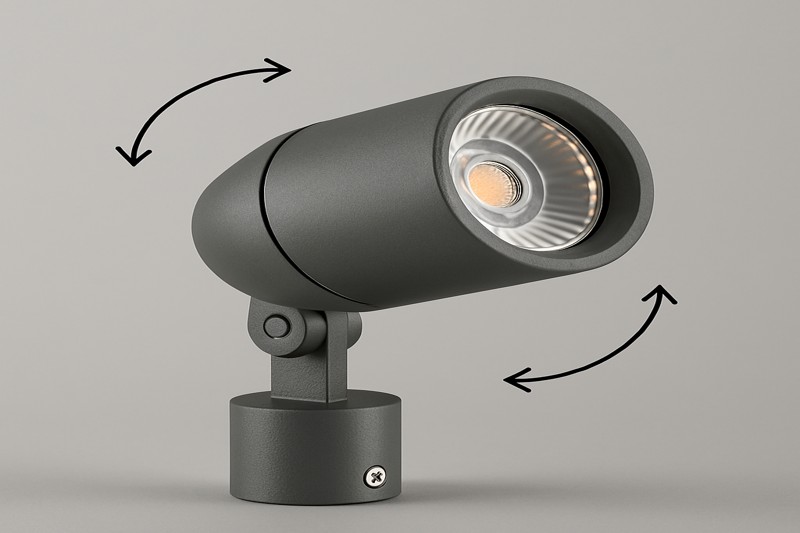
While color-changing RGB systems are impressive, you can achieve a sophisticated and dynamic look with simple white light. The key is in the application and the fixture selection. True dynamism comes from creating contrast—areas of light and shadow. We achieve this by using fixtures that give us control. For instance, many spotlights have an adjustable body (corpo luce orientabile) that allows us to aim the light with pinpoint accuracy. This is perfect for catching the edge of a window frame or the peak of a roof. We can also choose fixtures with different beam angles. A very narrow beam can create a sharp, dramatic line of light up a pillar, while a wider beam can wash an entire wall section in soft light. By alternating these techniques across a facade, you create a rhythm of light and shadow. This approach is not only cost-effective but also creates a timeless, elegant design that enhances the architecture itself.
Simple Techniques for a Dynamic Look
- Grazing7: Place fixtures very close to a textured surface like brick or stone. This creates long, dramatic shadows that reveal the material's depth.
- Scalloping: Space wall-mounted downlights evenly to create repeating arcs of light on a surface, adding a soft, rhythmic pattern.
- Highlighting8: Use narrow-beam spotlights to pick out individual features, like statues, emblems, or address numbers, making them pop from the background.
- Silhouetting: Light the wall behind an interesting object, such as a tree or sculpture, to frame it as a dark shape against a bright background.
Conclusion
Strategic LED facade lighting is a smart investment. It enhances architectural beauty, strengthens brand identity, and ensures your property makes a powerful statement long after the sun has set.
Understanding IP Ratings is crucial for selecting the right equipment for outdoor use, ensuring durability and safety. ↩
Exploring this topic helps you choose the right products based on their water resistance, enhancing safety and longevity. ↩
Explore this link to understand how uplighting can enhance architectural features and create stunning visual effects. ↩
Discover the impact of highlighting columns on design and ambiance, making spaces feel more dynamic and inviting. ↩
Understanding Color Appearance is crucial for creating the right ambiance in spaces, enhancing both aesthetics and functionality. ↩
Exploring the link between lighting and Brand Perception can help businesses create environments that resonate with their target audience. ↩
Explore this link to understand how grazing can enhance textures and create dramatic effects in your space. ↩
Discover effective highlighting techniques that can make features stand out beautifully in your interior or exterior design. ↩





